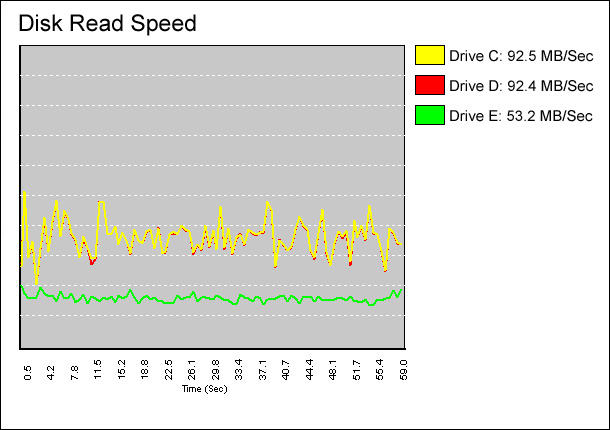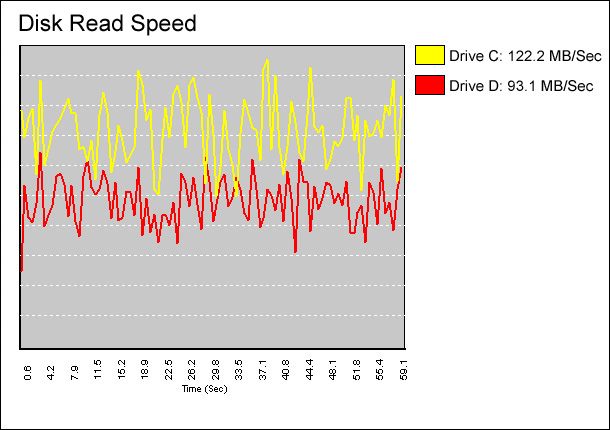 If there was ever a computer "good news, bad news" story, this is it.
If there was ever a computer "good news, bad news" story, this is it.
Pictured: Average reader upon hearing the bad news.
Well, there's no sense in beating around the bush. Let's get right to the good news.
For a mere $49.95, it's possible that you could more than double your hard drive speed. That means everything would be quicker. Boot-up time, saving, converting, copying, formatting, rendering, transcoding, frameserving, demuxing, remuxing, bitmapping, raytracing, defragging, scanning, disk-checking...
Everything.
For a crummy 49 bucks.
Think that's impressive? With the mere flip of a setting, you might be able to almost double it again.
More info and official techie-type graphs & numbers are below the fol-
"But Doc, wait! What about the bad news?"
Oh, let's just keep that between ourselves. There are children present.
I'm going to make you wait a little bit longer for the bad news, but you can probably guess. And it's only a possibility. Call it a 'worst case scenario'. Let's get your appetite whetted first.
Here's the output from Norton's Performance Test. There are three hard drives involved.
Legend
Higher = Faster
Faster = Better

That's the difference between the new SATA drives and the old IDE type. So it's obvious that SATA drives really scream.
But are all SATA drives the same?
Here are the same two, new, different Seagate SATA drives, but with the BIOS changed from 'IDE' to 'RAID':

That's what money and research buys. The faster drive, a Seagate 'Barracuda', was purposely sought out after reading some reviews on the latest in hard drive speeds and ordered from BestBuy online. It cost about $150. The less-faster one was grabbed right off the shelf when I was in BestBuy the other day for $99, on sale for $79. I knew it would be slower, but it's just a storage drive so there wasn't any point in blowing the extra bucks.
But the chart clearly shows there's a major difference between the two. As to whether or not your own SATA drive(s) will respond to the BIOS change, all you can do is give it a shot.
Update note: The original graphs I used were 'Instantaneous' speeds but they didn't reflect the 'Read MB/Sec' numbers people were expecting so there's a bit of confusion in the comments. The above graphs have been updated.
Drive Test & Identification
To test your before-and-after performance, here's a handy little tool called 'RdII' that'll do the trick. Download the file, unzip, find it a good home.
Run RdII. Set the box on the lower-right to '100'. Double-click on a drive name to test.
If you're unsure what type of drive(s) you have, open the tower and look. IDE drives will have a wide, flat, probably gray cable going to the back, SATA drives will have a couple of regular-looking wires, one of them most likely red. If you can't access the tower, download the above program, run it and look in the middle box. If it says 'SCSI' in the first column of the drive's row, it's SATA. If it says 'IDE', it's an old-style IDE drive.
(If anyone knows how to distinguish the two using Windows, I'd sure like to know. It just seems bizarre that tiny little RdII seems to view the stat as so important that it gives it an entire column, yet I can't find the "SCSI-SATA/IDE" dif anywhere in Device Manager or System Information.)
And Here It Comes
The bad news is, if you want to go from an IDE drive to a SATA drive, or from the 'IDE' setting in the BIOS to 'RAID' — if not both — you might have to reinstall Windows.
I quickly admit I did not pursue this, since I wanted to reinstall Windows anyway, but that was the gist I got glancing over the forums when my system wouldn't boot with the 'RAID' setting.
When it comes to going from an IDE drive to SATA, you'd first need to download the SATA/RAID driver from the new drive's web site, plug in the SATA drive as a spare drive and install the driver. You'd then use a program like Acronis True Image to make an image file of the C Drive, then use True Image to copy the C Drive image to the new SATA drive. That's what I initially did and it worked fine, although I still had to reinstall Windows because of the 'RAID' setting.
As far as the IDE/RAID setting goes, all you can do is try. For what it's worth, I tried the 'Repair' feature in the Windows install disc.
To access the BIOS, look for a quick message on the screen right after you turn on the computer. It'll usually want the F2, F10 or Delete key to be pressed. Once the BIOS program is up, use the arrow keys to navigate to (probably) the 'Advanced' panel, then look for a 'SATA Mode' setting. Get into the SATA settings area. Some BIOSes use the Enter key, others use the PageUp and PageDown keys — it should say somewhere in the side panel how to navigate around.
You'll see an 'IDE', 'RAID', and possibly an 'AHCI' setting. Select 'RAID' (possibly with the Enter key), then slide over to the 'Exit' panel and save the settings on the way out.
One of three things should happen:
1. It won't boot all the way up. You might see the Windows logo on the screen for a bit, but in my case it would suddenly recycle back to square one. Go back into the BIOS and set it back to 'IDE'. Plan on doing a Google search or asking in a forum if there's a way around reinstalling Windows. Don't be surprised if there isn't. Convince yourself that you've been wanting to anyway.
2. It'll boot up but, like my shelf-bought drive, it won't take advantage of the extra boost and your performance will be about the same. You might as well leave it in 'RAID' mode so the system will be ready should you ever reinstall Windows, so that your RAID-ready Windows will then be ready for a hotter drive that takes advantage of the RAID setting.
3. "Cowabunga!"
At least, that's what I said. As you can see in the above graph, this is a real, demonstrable difference, not just a few percentile points here and there.
As for reinstalling Windows, I always view the time it takes as a good investment. A fresh Windows is always perkier and snappier than one that's been thrashed around for a while. I slap in a fresh system about once a year.
The problem with installing Windows from scratch, as you might know, is that you only get three 'activations'. Worse, if you make a bunch of hardware changes down the road, at some point it might want to be activated again, and if you've already used up all three, it's off to the store for another copy of Windows — which will then have to be installed from scratch.
The trick is to install a brand-new Windows, make sure all of your devices (spare hard drives, flash sticks, PCI cards, network connections, etc) are hooked up, then get online and 'activate' it. Then you'd make an image file for future reinstallations so it won't ever have to be 'activated' again.


 If there was ever a computer "good news, bad news" story, this is it.
If there was ever a computer "good news, bad news" story, this is it.

Like you, I always stay up with the latest trends in file backup technology. Heck, who doesn't? Pictured: Who doesn't. To be completely honest, you never did have much of an excuse when you lost those super-important files during that computer
Tracked: Apr 13, 12:09
Programs AutoSizer — This has two great uses. It'll pop open the browser (or any program) in full-screen mode every time it opens, and for small programs that tend to open wherever they want (like Calculator), it will make them open right in
Tracked: Apr 16, 16:11
Here's an index of my Maggie's Computin' Tips. I can't guarantee all of these will work on every Windows operating system, but most should. Programs AutoSizer — This has two great uses. It'll pop open the browser (or any program) in full-s
Tracked: Jul 10, 11:23
Here's an index of my Maggie's Computin' Tips. I can't guarantee all of these will work on every Windows operating system, but most should. Programs AutoSizer — This has two great uses. It'll pop open the browser (or any program) in full-s
Tracked: Jul 10, 11:26
Here's an index of my Maggie's Computin' Tips. I can't guarantee all of these will work on every Windows operating system, but most should. Programs AutoSizer — This has two great uses. It'll pop open the browser (or any program) in full-scr
Tracked: Jul 22, 19:49
Here's an index of my Maggie's Computin' Tips. I can't guarantee all of these will work on every Windows operating system, but most should. Programs AutoSizer — This has two great uses. It'll pop open the browser (or any program) in full-scr
Tracked: Jul 22, 21:40
Here's an index of my Maggie's Computin' Tips. I can't guarantee all of these will work on every Windows operating system, but most should. Programs AutoSizer — This has two great uses. It'll pop open the browser (or any program) in full-s
Tracked: Jul 23, 13:07
Here's an index of my Maggie's Computin' Tips. I can't guarantee all of these will work on every Windows operating system, but most should. Programs AutoSizer — This has two great uses. It'll pop open the browser (or any program) in full-s
Tracked: Aug 28, 08:31
Here's an index of my Maggie's Computin' Tips. I can't guarantee all of these will work on every Windows operating system, but most should. Programs AutoSizer — This has two great uses. It'll pop open the browser (or any program) in full
Tracked: Jan 08, 20:00